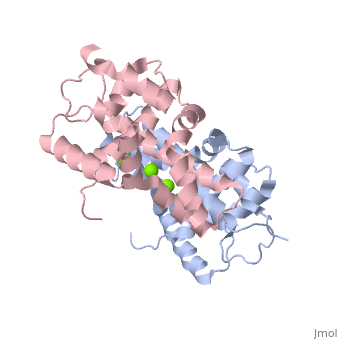Sandbox Dicer Corey
From Proteopedia
(Difference between revisions)
| Line 8: | Line 8: | ||
Dicer, or endoribonuclease Dicer, was discovered/named in 2001 by Emily Bernstein. She was a graduate student in Greg Hannon's lab at the Cold Spring Harbor Laboratory in New York. She was trying to discover the enzyme that was responsible for removing small RNA fragments from double-stranded RNA. The dicer enzyme was found by isolating it from the RISC complex in the RNAi mechanism. It was known that RISC was not responsible for chopping up these small RNA fragments, so this complex was isolated from the system to locate the enzyme that was the source for these RNA fragments. | Dicer, or endoribonuclease Dicer, was discovered/named in 2001 by Emily Bernstein. She was a graduate student in Greg Hannon's lab at the Cold Spring Harbor Laboratory in New York. She was trying to discover the enzyme that was responsible for removing small RNA fragments from double-stranded RNA. The dicer enzyme was found by isolating it from the RISC complex in the RNAi mechanism. It was known that RISC was not responsible for chopping up these small RNA fragments, so this complex was isolated from the system to locate the enzyme that was the source for these RNA fragments. | ||
| - | Dicer is a member of the RNase III family, is known as drosophilia CG4792 and it is found in multiple organisms | + | Dicer is a member of the RNase III family, is known as drosophilia CG4792 and it is found in multiple organisms. The discovery of Dicer was important for understanding the regulation of gene expression and the epigenetic silencing of genes by miRNA. The human endoribonuclease Dicer is 219 kDa, which is larger than many other organisms' Dicer enzymes. This is due to Humans having different domains present, and in many cases, more domains. |
| - | + | ||
| - | The human endoribonuclease Dicer is 219 kDa, which is larger than many other organisms' Dicer enzymes. This is due to Humans having different domains present, and in many cases, more domains. | + | |
== Structure == | == Structure == | ||
| - | Human Dicer is made up of | + | Human Dicer is made up of |
| - | + | ||
<scene name='60/602707/Trench/2'>TextToBeDisplayed</scene> | <scene name='60/602707/Trench/2'>TextToBeDisplayed</scene> | ||
Revision as of 02:06, 14 October 2014
==Introduction==
| |||||||||||
References
- ↑ Hanson, R. M., Prilusky, J., Renjian, Z., Nakane, T. and Sussman, J. L. (2013), JSmol and the Next-Generation Web-Based Representation of 3D Molecular Structure as Applied to Proteopedia. Isr. J. Chem., 53:207-216. doi:http://dx.doi.org/10.1002/ijch.201300024
- ↑ Herraez A. Biomolecules in the computer: Jmol to the rescue. Biochem Mol Biol Educ. 2006 Jul;34(4):255-61. doi: 10.1002/bmb.2006.494034042644. PMID:21638687 doi:10.1002/bmb.2006.494034042644

